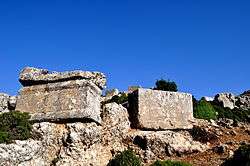Ariassos
 Ancient entrance to the city | |
 Shown within Turkey | |
| Location | Antalya Province, Turkey |
|---|---|
| Region | Pisidia |
| Coordinates | 37°10′52″N 30°28′21″E / 37.18111°N 30.47250°ECoordinates: 37°10′52″N 30°28′21″E / 37.18111°N 30.47250°E |
| Type | Settlement |
| Site notes | |
| Condition | In ruins |
Ariassos (Άριασσός) or Ariassus (Latinized form) was a town in Asia Minor built on a steep hillside about 50 kilometres inland from Attaleia (modern Antalya).
History
The town was founded in the Hellenistic period in the 3rd century BC.[1] It was mentioned (as Aarassos) in about 100 BC by Artemidorus Ephesius, who was quoted by Strabo a century later. The only further mentions are by Ptolemy in the 2nd century AD and in lists of Christian dioceses (Notitiae Episcopatuum).[2]
It was part of Pisidia, and belonged originally to the Seleucid Empire. In 189 BC it passed to the hellenistic kingdom of Pergamum, the last king of which, Attalus III left his kingdom the Rome in 133 BC.[3]
Under Octavian Augustus, Ariassos was made part of the Roman province of Galatia.[2] In the ecclesiastical lists it appears in the late Roman province of Pamphylia Secunda, whose capital was Perge, hence also its bishopric's Metropolitan.
Remains

Coins minted at Ariassos are extant.[4][5]
The ruins are mainly of Roman and Byzantine times, with few remains of the earlier Hellenistic period. The best preserved is that of the 3rd-century-AD triple-arched city entrance once surmounted by four statues. Other building include an extensive nymphaeum and baths, as well as a large domestic area. There is an abundance of funerary monuments.[6][7]
Bishopric
The names of three bishops of the see of Ariassus are known: Pammenius (at the First Council of Constantinople in 381); Theophilus (at the Council of Chalcedon in 451); and Ioannes (signatory of a joint letter of the bishops of the province to Emperor Leo I the Thracian in 458).[8][9]
Titular see
No longer a residential bishopric, Ariassus is today listed by the Catholic Church as a titular see.[10]
Nominally restored as a Latin titular bishopric in 1911, it is vacant, having had the following incumbents, all of the lowest (episcopal) rank :
- Jules-Joseph Moury, Society of African Missions (S.M.A.) (1911.01.17 – 1935.03.29)
- Leoncio Fernández Galilea, Claretians (C.M.F.) (1935.06.18 – 1957.02.15)
- Jean Fryns, C.S.Sp. (1957.04.12 – 1959.11.10)
- Cesar Gerardo Vielmo Guerra, Servites (O.S.M.) (1959.12.19 – 1963.06.16)
- Ignacio María de Orbegozo y Goicoechea (1963.10.29 – 1968.04.26)
References
- ↑ Kemer Turkey Info, "Ariassos"
- 1 2 Stephen Mitchell, Edwin Owens and Marc Waelkens, "Ariassos and Sagalassos 1988" in Anatolian Studies, Vol. 39, 1989
- ↑ S. Rinaldi Tufi, "Ariassos" in Enciclopedia dell'Arte Antica (1994)
- ↑ Ancient Coinage of Pisidia, Ariassus
- ↑ Asia Minor Coins: Ariassos
- ↑ Sarah H. Cormack, "The Roman-Period Necropolis of Ariassos, Pisidia" in Anatolian Studies, vol. 46, Dec. 1996, pp. 1-25
- ↑ Antik Şehirler: Ariassos
- ↑ Michel Lequien, Oriens christianus in quatuor Patriarchatus digestus, Paris 1740, Vol. I, coll. 1023-1024
- ↑ Pius Bonifacius Gams, Series episcoporum Ecclesiae Catholicae, Leipzig 1931, p. 450
- ↑ Annuario Pontificio 2013 (Libreria Editrice Vaticana 2013 ISBN 978-88-209-9070-1), p. 838



